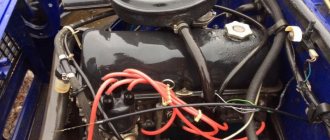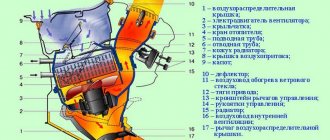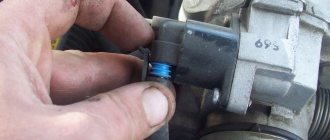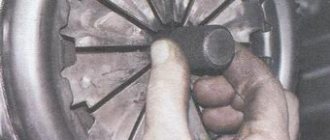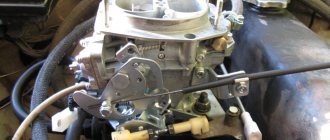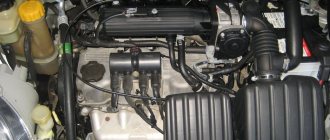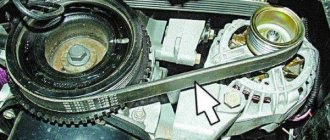Timing belt with chain drive on VAZ 2101
The “kopek”, like all other “classic” models, has a timing chain drive. The mechanism consists of a double-row metal chain and additional elements that ensure its tension and prevent vibrations. The well-coordinated operation of the motor directly depends on the integrity and serviceability of each part of the mechanism. The chain drive connects the crankshaft and camshaft and ensures their synchronous operation. When the shafts rotate, the pistons in the engine cylinders are set in motion, and the valves in the cylinder head (cylinder head) open and close in a timely manner.
The main elements of the VAZ 2101 timing drive are a chain, a damper, a shoe, a tensioner and sprockets
Tranquilizer
The damper performs the function of damping circuit vibrations. Without it, the chain may jump or fly off the sprockets of the timing mechanism. If the damper breaks down, the drive may simply break off. Such a nuisance is possible at high engine speeds. If the chain breaks, the pistons and valves are damaged, requiring expensive repairs. Therefore, the condition of the damper must be monitored and replaced in a timely manner. The part is a durable metal plate with special holes for fastening.
The chain damper dampens its vibrations when the engine is running.
Opposite the damper there is a shoe, which is also responsible for calming and tensioning the chain. It is made of a special polymer material, which gives the part high wear resistance.
The tensioner shoe is responsible for tensioning the chain and damping vibrations together with the damper
Tensioner
The “penny” chain drive tensioner prevents the chain from loosening when the motor is running. The element comes in several types:
- auto;
- mechanical;
- hydraulic.
Automatic tensioners began to be produced recently, but with regard to this part, it is already possible to note the pros and cons. The main positive point is that there is no need to make periodic adjustments, i.e. the drive is constantly in tension. The disadvantages include fairly quick failure and high cost of the part. In addition, based on reviews from car enthusiasts, the auto tensioner does not tension the chain very well.
The operation of hydraulic devices is based on the supply of oil under pressure from the engine lubrication system. With this design, the driver does not need to worry about periodically tightening the chain. However, over time, the part may malfunction, which manifests itself in the form of jamming of the mechanism.
The VAZ classic uses a mechanical tensioner. The part has a significant drawback: over time, it becomes clogged with small particles, the plunger jams and the device loses its ability to produce tension.
The chain tensioner is designed to keep the chain taut at all times.
Chain
One of the key elements of the timing chain drive is the chain itself, made of metal and having a certain number of links: on the VAZ 2101 there are 114 of them. Compared to a belt drive, the chain is more reliable and has a longer service life.
The chain is considered a more reliable element compared to the belt
Depending on the quality of the chain and the operating conditions of the vehicle, it is replaced every 60–100 thousand km. There are cases that a part lasts for 200 thousand km, but it’s hardly worth the risk, because a broken chain will result in a much more expensive repair than its timely replacement.
The chain is tightened every 10 thousand km, even in the absence of signs indicating sagging.
When is stretching necessary?
The gas distribution mechanism on the VAZ 2107 injector consists of the following elements:
- intermediate and crankshaft gears;
- camshaft and intermediate shaft;
- rocker;
- sedative;
- intake and exhaust valve;
- tensioner;
- shoe;
- timing chain drive.
The photo shows timing parts.
Components of the gas distribution mechanism
Thanks to the timing belt, the air-fuel mixture is supplied and exhaust gases are removed. Its operation is carried out using a chain drive or belt. They transmit torque from the crankshaft to the camshaft.
The shafts must be in a certain position. To do this, special marks are placed on the crankshaft pulley and the camshaft sprocket, which must be set correctly. If the marks do not match, serious problems with the engine may occur, including major engine repairs.
During operation, the chain drive and belt are under constant tension, so after a while the chain gradually stretches - its pitch increases. In this case, the engine begins to idle unstably, the speed begins to fluctuate, and the engine may stall.
If metallic sounds appear when increasing or decreasing speed, this is a sure sign of stretching of the chain drive or wear of the damper. To eliminate these sounds, you need to tighten the chain or replace the damper. Chain drive tensioning should also be done after replacing any timing parts, including the guide rail and shoe.
The chain drive on the VAZ 2107 injector is adjusted using a tensioner, which can be a mechanical, automatic or hydraulic tensioner. To install a hydraulic tensioner on a VAZ 2107, you need to redo the timing belt. Instead of the standard one, an automatic tensioner is often installed; it is more reliable.
Diagram of the gas distribution mechanism
Chain mechanism fault detection
The timing drive, equipped with a chain, is structurally located inside the engine. To determine the condition of the parts of this mechanism, it is necessary to partially disassemble the motor. The fact that there are problems with the chain or drive elements is indicated by characteristic signs.
The chain is noisy
A circuit can have different types of noise:
- noise under load;
- knocking on a warm engine;
- extraneous sounds when cold;
- constant noise with a metallic character.
If the motor begins to make sounds that are uncharacteristic of its normal operation, it is necessary to find out as soon as possible what problems have arisen with the chain drive and eliminate them. If this is not done, wear on the timing drive elements will increase, which can lead to costly repairs.
Video: chain knocking in a VAZ “classic” engine
Timing drive components may fail prematurely for the following reasons:
- the use of oil not specified by the car factory, or its untimely replacement;
- use of low-quality parts;
- low lubricant pressure in the engine;
- failure to comply with engine maintenance regulations;
- low quality of repairs.
Often the chain is noisy due to stretching or problems with the tensioner. Attempts to tighten it turn out to be useless, and the engine sounds like a diesel engine. The sound most often appears on a cold engine when idling.
The timing chain stretches over time, so it needs to be periodically tightened or replaced
Jumped the chain
With high mileage of the vehicle, the timing chain stretches. As a result, it can simply jump to other teeth of the camshaft or crankshaft gears. This problem may occur when the timing drive parts are damaged. If the chain jumps by at least one tooth, the ignition is greatly shifted and engine operation becomes unstable (sneezes, shoots, etc.). To fix the problem, you will need to check the integrity of the parts, and if damage is detected, make repairs.
Signs of a poorly adjusted chain
When they talk about a poorly adjusted chain, they usually mean a loose and sagging chain. Because a highly tensioned chain does not show any signs of breakage. She's just bursting. Here are the main signs that the timing chain has become loose:
- after starting the engine, a loud grinding and knocking noise is heard from under the hood, the frequency of which increases as the crankshaft speed increases. This occurs due to the fact that the slack chain continuously hits the damper and the tension shoe;
- the car reacts poorly to pressing the gas pedal: the engine begins to increase speed only one or two seconds after pressing. This is due to the fact that due to a sagging chain, the synchronism of rotation of the timing shaft and the crankshaft is disrupted;
- There are power failures in engine operation. Moreover, they can occur both when accelerating and when the engine is idling. Due to the desynchronization of the shafts, which was mentioned above, the operation of the cylinders in the engine is also disrupted. In this case, one cylinder either does not work at all, or works, but not at full strength;
- increase in fuel consumption. If the cylinder block is not working properly, this cannot but affect fuel consumption. It can increase by a third, and in especially severe cases - double.
If the driver notices one or more of the above signs, this only means one thing: it’s time to remove the timing chain and check for wear. If it turns out to be very worn, it will have to be replaced. If the wear is minor, the chain can simply be tightened slightly.
Installing the chain by marks
The need to install marks on the timing mechanism may arise during the repair process or when the chain is severely stretched. If the marks do not match, the stable operation of the motor is disrupted due to a phase shift. In this case, an adjustment is required. The work is carried out with the following tools:
- Screwdriver Set;
- key for rotating the crankshaft;
- a set of keys.
To install the chain according to the marks, you will need a standard garage tool kit.
We carry out the procedure according to the following instructions:
- We dismantle the air filter box and the valve cover with the seal by unscrewing the fasteners.
- Loosen the tensioner clamp, press the screwdriver against the shoe and tighten the nut.
- Using a 38 mm wrench or a crank, turn the crankshaft until the marks on its pulley and the timing cover match, and the mark on the camshaft sprocket should be located opposite the protrusion cast on the body.
- If any of the marks do not coincide, turn on the fourth speed and unbend the lock washer on the camshaft sprocket.
- We unscrew the bolt and remove the gear.
- Remove the chain from the sprocket and set the desired position (step 3). After installing the marks, we perform reverse assembly.
You can turn the crankshaft with a 38 mm spanner.
Video: how to set timing marks on classic Zhiguli cars
Do-it-yourself timing chain replacement
The procedure requires attention and accuracy. If you are used to doing car repairs yourself, then replacing the chain should not pose any particular difficulties. Before starting work, you must prepare the appropriate tools. The list may vary depending on the car brand. We will look at replacing a part using the Nissan Almera as an example. You will need the following set of tools:
- hex key 6;
- heads for 12, 13, 14;
- chisel and small hammer;
- rags;
- containers so that liquids can be drained;
- torque wrench and adjustable wrench;
- block of wood;
- degreaser and sealant;
- new chain.
The dismantling procedure is carried out as follows:
- We start by removing the wires from the ignition coils and unscrewing them. We put the details aside. In order not to confuse anything during the assembly process, it is better to number everything.
- The air hoses are removed from the valve covers. The cover is secured with bolts. It will also need to be removed, then access to the circuit will open.
- The right engine mount is removed. Otherwise, it will interfere with disassembly.
- We substitute a suitable container, unscrew the cap and drain the engine oil. We wait until it drains completely and remove the oil filter.
- We take another container and drain the antifreeze from the radiator, opening the lid so that the liquid drains completely.
- Next, the cooling radiator is dismantled, the generator drive belt and the inlet pipe clamp are removed.
- The next stage is dismantling the cylinder head. The assembly head cover is secured with four screws. We unscrew them and remove the cover along with the fan and related elements.
- You will need to unscrew the engine sump. To do this, remove the muffler, which is secured with several bolts.
- Loosen the screws securing the pump pulley. This will allow you to remove the belts suitable for the climate and control system.
- It is necessary to find a space between the crankshaft and the side of the crankcase. Place a block of wood here and remove the crankshaft pulley. To unscrew the bolt, use a head of the required size.
- Next, remove the pump pulley. There is a gasket underneath that will also need to be removed. The oil pump is also temporarily dismantled.
- This completes the preparation for removing the chain. You can start dismantling it. The camshaft gears are secured with screws that need to be unscrewed. The camshaft is fixed with an adjustable wrench.
The chain is dismantled in the following sequence:
- The chain guide is removed (bar at the top).
- We remove the tensioner and the bar that is responsible for tensioning the damper. The tensioner must be carefully inspected and may need to be replaced.
- The bottom strap is put on a hairpin.
- We remove the chain.
- Using a flathead screwdriver, remove the gear located below.
- Now you can compare the new part with the old one. The difference should be noticeable: the old chain will have a longer length.
- Next, install a new chain, lubricating it with engine oil.
- The assembly process is carried out in reverse order. All parts of the mechanism must be cleaned. To clean the side of the engine, a degreaser and a clean rag will be useful.
- To install the chain correctly, you need to make sure that the mark on it matches the marks on the pulleys. Next, the side of the motor is lubricated with sealant, and the bolts that secure the cover are tightened. You need to wait a while for the sealant to dry. All subsequent assembly steps are performed in reverse order.
Video: example of replacement on a Nissan Almera car
How can it be located
Typically, in engines with a timing chain drive, its location can be front or rear. The first option involves installing the drive on the drive element side. In the second option, the drive is located on the side of the gearbox and flywheel. The front location is the most common and there is a logical explanation for this: easier repair and maintenance. Despite its less popularity, the second option is also used by such well-known brands as Audi and BMW.
According to manufacturers, the drive element breaks as a result of non-compliance with the recommendations given in the instruction manual. The chain is closely connected to a part such as a tensioner. It may fail due to the use of low-quality oil. Its service life also depends on the pressure in the lubrication system. If the engine consumes oil and no action is taken to correct the problem, then over time the pressure in the system will decrease. As a result, the chain will not be properly tensioned, which will lead to its breaking.
Chain tension after replacement
After the part is replaced, it will need to be tensioned. Let's take a VAZ 2101 car as an example. Before you begin the procedure, you need to make sure that there is no mechanical damage to the main timing elements, for which you remove the valve cover. If there are defects, replace damaged parts. To tension the chain you will need:
- keys for 13 and 38;
- flat screwdriver;
- pliers.
The car is first placed on a convenient platform, and stops are placed under the wheels to avoid accidental movement. The gearshift lever (gearbox) is switched to the neutral position. Further:
- The tensioner is located near the water pump under the pipes. Using the 13 key, release it. When the chain is loosened, the shoe should snap off.
- Using a 38mm wrench, turn the crankshaft pulley 2 turns clockwise.
- The shaft is turned until the marks on the bearing housing and on the camshaft match. When turning the crankshaft, the required chain tension will occur.
- Use a screwdriver to check the tension. If the chain is tight, then use a 13 key to tighten the tensioner.
Video: how to properly adjust chain tensioners
After these steps, you need to check the operation of the engine. There should be no extraneous noise. If they remain, then the sedative may be the cause. In this case, check its serviceability and, if necessary, replace it.
Important: when adjusting the chain tension, you need to follow the marks so that the valve timing does not change.
It is important to replace the timing chain promptly and correctly. You can do the procedure yourself, following the step-by-step instructions.
Adjusting chain tension
The need to tighten the chain may be necessary in different situations:
- engine repair;
- replacing the chain drive;
- chain stretching.
To work you will need the following tools:
- 13 and 38 mm keys;
- flat screwdriver;
- pliers.
Tensioning the chain consists of several steps:
- We place the car on a flat surface, turn on neutral, placing stops under the wheels.
- We unscrew the chain tensioner clamp, and a characteristic click will be heard.
- Use a 38 mm wrench to rotate the crankshaft, making several revolutions.
- Stop rotation at maximum force and tighten the tensioner nut.
If the valve cover is removed, you can determine the tension of the chain by pressing it with a screwdriver . If the chain is tensioned normally, it will be stiff.
The chain tension with the valve cover removed can be checked with a screwdriver.

